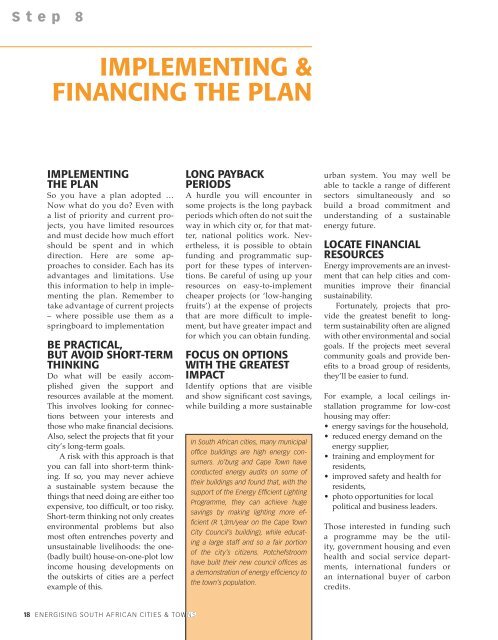Energising South African Cities & Towns - City Energy Support Unit
Energising South African Cities & Towns - City Energy Support Unit
Energising South African Cities & Towns - City Energy Support Unit
Create successful ePaper yourself
Turn your PDF publications into a flip-book with our unique Google optimized e-Paper software.
S t e p 8IMPLEMENTING &FINANCING THE PLANIMPLEMENTINGTHE PLANSo you have a plan adopted …Now what do you do? Even witha list of priority and current projects,you have limited resourcesand must decide how much effortshould be spent and in whichdirection. Here are some approachesto consider. Each has itsadvantages and limitations. Usethis information to help in implementingthe plan. Remember totake advantage of current projects– where possible use them as aspringboard to implementationBE PRACTICAL,BUT AVOID SHORT-TERMTHINKINGDo what will be easily accomplishedgiven the support andresources available at the moment.This involves looking for connectionsbetween your interests andthose who make financial decisions.Also, select the projects that fit yourcity’s long-term goals.A risk with this approach is thatyou can fall into short-term thinking.If so, you may never achievea sustainable system because thethings that need doing are either tooexpensive, too difficult, or too risky.Short-term thinking not only createsenvironmental problems but alsomost often entrenches poverty andunsustainable livelihoods: the one-(badly built) house-on-one-plot lowincome housing developments onthe outskirts of cities are a perfectexample of this.LONG PAYBACKPERIODSA hurdle you will encounter insome projects is the long paybackperiods which often do not suit theway in which city or, for that matter,national politics work. Nevertheless,it is possible to obtainfunding and programmatic supportfor these types of interventions.Be careful of using up yourresources on easy-to-implementcheaper projects (or ‘low-hangingfruits’) at the expense of projectsthat are more difficult to implement,but have greater impact andfor which you can obtain funding.FOCUS ON OPTIONSWITH THE GREATESTIMPACTIdentify options that are visibleand show significant cost savings,while building a more sustainableIn <strong>South</strong> <strong>African</strong> cities, many municipaloffi ce buildings are high energy consumers.Jo’burg and Cape Town haveconducted energy audits on some oftheir buildings and found that, with thesupport of the <strong>Energy</strong> Effi cient LightingProgramme, they can achieve hugesavings by making lighting more efficient (R 1,3m/year on the Cape Town<strong>City</strong> Council’s building), while educatinga large staff and so a fair portionof the city’s citizens. Potchefstroomhave built their new council offi ces asa demonstration of energy effi ciency tothe town’s population.urban system. You may well beable to tackle a range of differentsectors simultaneously and sobuild a broad commitment andunderstanding of a sustainableenergy future.LOCATE FINANCIALRESOURCES<strong>Energy</strong> improvements are an investmentthat can help cities and communitiesimprove their financialsustainability.Fortunately, projects that providethe greatest benefit to longtermsustainability often are alignedwith other environmental and socialgoals. If the projects meet severalcommunity goals and provide benefitsto a broad group of residents,they’ll be easier to fund.For example, a local ceilings installationprogramme for low-costhousing may offer:• energy savings for the household,• reduced energy demand on theenergy supplier,• training and employment forresidents,• improved safety and health forresidents,• photo opportunities for localpolitical and business leaders.Those interested in funding sucha programme may be the utility,government housing and evenhealth and social service departments,international funders oran international buyer of carboncredits.18 ENERGISING SOUTH AFRICAN CITIES & TOWNS












